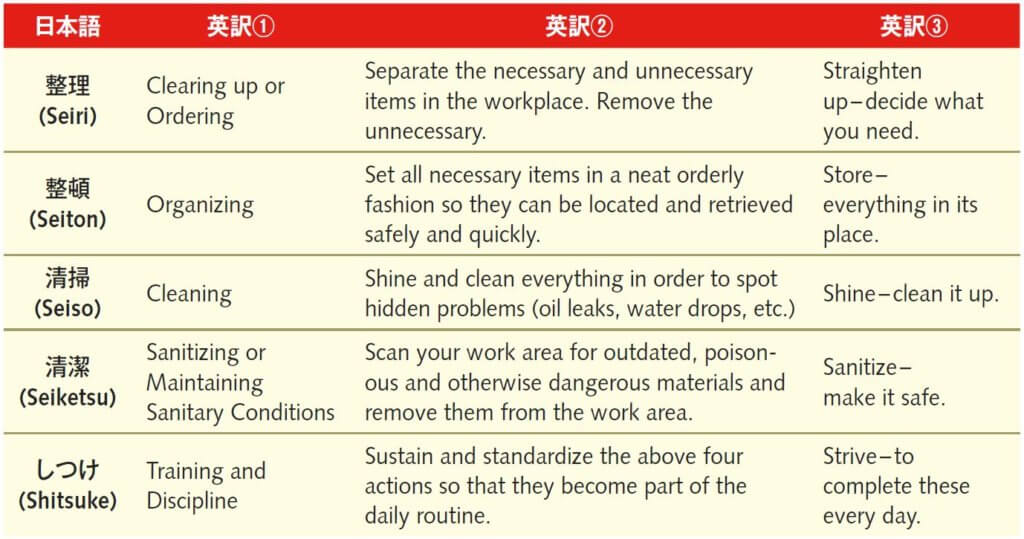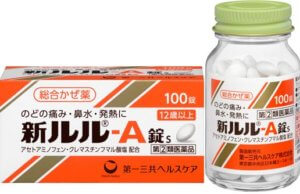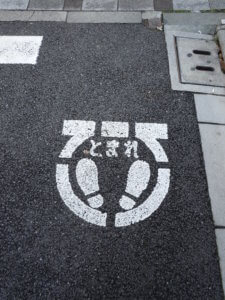What is 5S in the Japanese Workplace? (1)
CONTENTS
Why the Japanese Have Difficulty Explaining 5S?
Most non-Japanese business people especially factory workers must know something about 5S. A Google search will find multiple variations of the definitions of the five concepts, sometimes Seiri = sorting, Seiton = organizing, Seiso = cleaning, Seiketsu = sanitizing and Shitsuke = sustaining. Other times Seiri = organizing or clearing up or ordering. Are they confusing? The top search results are consultants to help roll out 5S programs and manufacturers of tags and labels. A search of the history of 5S traces it back to the 1950s, a time when the Japanese were refining their innovative lean manufacturing systems.
Unfortunately, 5S programs are often seen as management initiatives set on top of or apart from the work itself. For many of you non-Japanese people, 5S consists of labels, white lines and meetings. However, 5S is much more than a manufacturing methodology. The reason that the Japanese have such difficulty explaining 5S is that the concepts are deeply rooted in Japanese values, culture, religion and practice. Why should a fish need to explain water?
Important to Know the Cultural Roots of 5S
In order to work more effectively with the Japanese workers, it is important to have a deeper knowledge of these five concepts and how they relate to 5S initiatives. This will enable you to not only meet the Japanese expectations in this regard but to proactively identify and eliminate sources of frustration and irritation.
5S—the Basics
The following table shows the basic 5S definitions and activities.

5S chart
Space Is Precious
Most urban Japanese have learned to live in very confined spaces. For some families, the living room is also the dining room and is also the bedroom. During the day the bedding must be put away to make room for daytime activities. At night, the table and seats must be put away so that the bedding can be laid down. There is no room for unnecessary items or clutter. Items that are not in daily use must be stored efficiently or thrown away.
Importance of Visuals
As a communications media, the Japanese rely on images as well as text. The popularity of white boards, PowerPoint images, visual aids used in television news, and even little cartoons in government publications speaks to the importance of visuals to supplement words. Visual observation is also a key aspect of 5S. Every step requires taking another look at everyday items and practices. Many steps involve marking or labeling items and processes in a way that their state or purpose can be easily visually identified.
Let’s look more closely at the 5S concepts, starting with Seiri.
Seiri—Clearing up and Ordering
A simple description of Seiri action is “Separate the necessary and unnecessary items in the workplace. Remove the unnecessary.”
Seiri-(整理)
The origin of the word goes back at least 2,500 years to the Chinese Confucian philosophers. “Ri”(理) is “harmony,” “order” and “morality.” Literally, “seiri” means “establishing ‘ri.’” Its opposite is “muri”(無理), or “non-ri,” wasted labor, unreasonableness and absurdity. In Japanese, the character for “ri” can also be pronounced “kotowari,” which means “separating out,” “rejecting” and “refusing.” Without separating and rejecting, order cannot be established.
①Identifying What Is Unnecessary
Seiri involves taking a fresh look at the workplace and identifying unnecessary items. Clutter can pose a hazard on the work floor. Clutter makes it difficult to see the items that are needed for work. However, throwing away items, especially if they have potential value, is not that easy. Eliminating clutter requires the establishment of criteria for keeping or getting rid of items.
②Identifying What Is Necessary
In order to know what is necessary, the purpose of the activity at hand must be clearly identified. This is where Japanese Buddhist thought comes into play. Keeping in mind “Do what you are doing and do not do what you are not doing” provides a basis for Seiri activity. This means coming to terms with the now and eliminating what is not now.
③Rejecting and Letting Go
Identifying and eliminating unnecessary items means giving up illusions and letting go of possibilities. An example is getting rid of tools purchased for producing a product that is not needed in the marketplace. It also means giving up on failures. An example is getting rid of parts left over from a project that failed miserably. Seiri means denying the possibilities of “we might need that someday” and accepting that we won’t.
Seiri-- observing, identifying, separating and rejecting—and keeping.
Next month let’s look at Seiton (整頓), what we do with the stuff we keep.
- Categories
- 5S, About Japanese companies and Japanese business people, and 未分類


